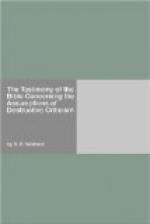Did the Savior know what he was talking about? Did he know the truth of the statement he made? Or, knowing (as is assumed) that there were no such events, did he resort to fiction in order to assert the certainty of his own resurrection? If the latter, then we must correct his statement concerning Jonah, and read: “As Jonah has been fictitiously represented to have been three days and three nights in the whale’s belly, so, fictitiously, shall the Son of man be three days and three nights in the heart of the earth.”
Our Sunday-school teachers, with the words of Christ before them, will be able to give the critics important information. They can report the certainty of the historical facts.
IX. RADICAL EXPOSITION.
"Among you also there shall be false teachers, who shall privily bring in destructive heresies, denying even the Master that bought them, bringing upon themselves swift destruction.” (R.V.) 2 Peter ii. 1.
"O Timothy, keep that which is committed to thy trust, avoiding profane and vain babblings, and oppositions of science falsely so called, which some professing have erred concerning the faith.” 1 Tim. vi. 20, 21.
"Take heed unto thyself, and unto the doctrine; continue in them.” 1 Tim. iv. 16.
"We have also a more sure word of prophecy, whereunto ye do well that ye take heed, as unto a light that shineth in a dark place until the day dawn, and the day star arise in your hearts.” 2 Peter i. 19.
The destructive critics have pushed their work far into the field of both prophecy and exposition. They have relegated to the domain of mythology the clear and unequivocal historical statements of Scripture. Where the intrusion of their mythological theory was too large a demand to make on our credulity, they have attempted a radical exegesis in proof of their assumptions.
They claim to have discovered that the Church in all the past has misconceived the first prophetic promise given to man. That promise was given to our first parents immediately after the fall. God said to the serpent (Gen. iii. 15): “I will put enmity between thee and the woman, and between thy seed and her seed. It shall bruise thy head and thou shalt bruise his heel.”
Our critics have two objections to the interpretation that has always been given and maintained by Christian scholars and by the Church as a whole. First, that “the seed of the woman” does not refer to the Messiah, but to the human race, which is to bruise the serpent’s head. Second, that the serpent engaged in seducing Eve, and here placed under the curse, does not refer to Satan.
In replying to the objection that the Messiah is not referred to in the passage, let it be said that the pronoun is a pronoun referring to a person. It is so translated in the Revised Version. “He shall bruise thy head and thou shalt bruise his heel.” It is not the human race, but he, an individual person. This person was not to be the seed of the man, but of the woman.




